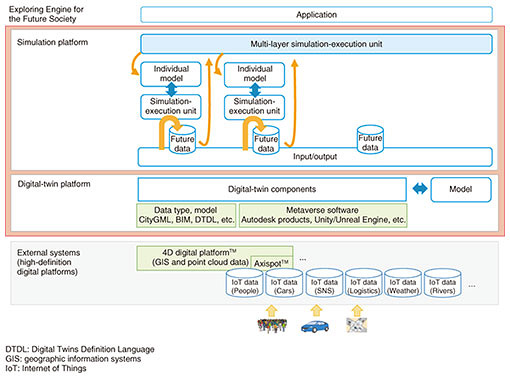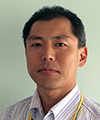 |
|||||||||||
|
|
|||||||||||
|
Feature Articles: Technology Development for Achieving the Digital Twin Computing Initiative Vol. 20, No. 3, pp. 26–30, Mar. 2022. https://doi.org/10.53829/ntr202203fa4 Initiatives toward Development of the Exploring Engine for the Future SocietyAbstractThis article introduces the “Exploring Engine for the Future Society,” one of the grand challenges toward actualizing the Digital Twin Computing concept and outlines its architecture and three key technologies. Keywords: Exploring Engine for the Future Society, grand challenges, essential layer selection 1. Goals of the Exploring Engine for the Future SocietyThe sophistication of social structures and increasing number of natural disasters and other uncertain events have made it difficult to determine the impact of individual actions and cooperation on social and natural environments, as well as the resulting benefits to individuals. Therefore, to enable the exploration of social and lifestyle approaches for coexisting with nature, we are conducting research and development on the Exploring Engine for the Future Society. We are studying frameworks for using digital twins to accurately represent a society where people carry out their activities, as well as for exploring the future by enabling interactions between digital twins while making repeated changes in people’s behavior. To develop the Exploring Engine for the Future Society, we are aiming to incorporate not only the known interactions between objects, such as interactions in traffic flow, but also complex and unknown human interactions, such as those involving emotions, into digital twins. We are also conducting modeling that incorporates information propagation, crowd psychology, and collective dynamics. Using high-definition geospatial and sensing information, we are also developing simulation platform technologies for constructing digital twins of the real world in real time and simulations that are specific to individual models to visualize, for example, the future resulting from interactions between human flow and information propagation. These technologies drive the digital twins of society, enabling the presentation of various future scenarios as well as possible measures that should be taken now through backcasting from the ideal vision of society. We believe that various collaborations can be reinforced if residents of the local community, as well as government and corporate management, see the same future image through the visualization of the future society in different ways. We also aim to achieve a world that encourages voluntary activities and in which individuals can proactively think of and discover actions and collaborations for achieving the type of society they wish to build (Fig. 1).
2. Architecture of the Exploring Engine for the Future SocietyAs shown in Fig. 2, the Exploring Engine for the Future Society is linked with external systems, such as the 4D digital platformTM (high-definition digital platform), to obtain high-definition geospatial information and real-world sensing information. The Exploring Engine for the Future Society is composed of two major fundamental technologies. The first is the digital-twin platform that provides a variety of data as components of a digital twin for building a virtual society. The second is the simulation platform that couples multi-layer simulations, such as for human flow, traffic flow, and information propagation, in accordance with the keywords that users input into the application search criteria for the future they envision. The platform, therefore, enables accurate capture of the changes in society where people carry out their activities, towards driving and visualizing a virtual society.
The digital-twin platform can be connected as needed to external high-definition digital platforms using interfaces such as the City Geography Markup Language (CityGML) and the Building Information Model (BIM). Digital twins for people, things, etc. are then constructed in real time on the basis of the data collected from the high-definition digital platforms. The data are made available as components of the digital twins, the information of which is updated synchronously with reality. We are considering using current metaverse software*1, such as Autodesk products and Unity/Unreal Engine, to configure digital twins. The simulation platform has a multi-layer simulation-execution unit containing individual simulation-execution units specific to individual models, such as human flow and traffic flow. The multi-layer simulation-execution unit of the simulation platform first obtains the necessary digital-twin components from the digital-twin platform depending on the keywords supplied by the application. The digital-twin components and several simulation-execution units are then used to couple simulations and calculate the interactions between various layers, such as human flow, traffic flow, logistics, weather, rivers, as well as information propagation through social networking services (SNS), resident behavior, and resident consciousness. The results of the linking and calculations are then returned to the application. Considering the interaction of various layers enables the calculation of, for example, the effects of human flow due to information propagation from a few minutes to a few years into the future.
3. Core technologiesDeveloping the Exploring Engine for the Future Society, which requires high-precision simulation of the future, is difficult to achieve with current technologies due to three major issues. First, although there is a wide variety of simulation technologies available, there is no technology that can select the best layer (or layers) from among the large number of simulation layers when carrying out flexible searches. Second, because the configurable parameters for current simulations are fixed before running simulations, it would not be possible to handle new parameters that must be considered if a sudden event occurs at some point in the future (catastrophes, major inventions, etc.). The third issue is that since typical simulations produce results by setting parameters and models first, they cannot carry out reverse simulation by setting the desired future society first then calculating and solving the intermediate process to arrive at that society. To address these three technical issues, NTT undertook the development of three technologies; essential-layer-selection technology, what-if simulation technology, and inverse simulation technology. (1) Essential-layer-selection technology This technology extracts only those layers that are highly relevant to the search terms from among the large number of layers that exist, depending on the search terms entered by the user. First, attributes such as “event,”*2 “location,”*3 “time,”*4 and “numerical value”*5 are extracted from the search terms. Next, “event,” “location,” and “time” are entered for each of the large number of layers provided by the Exploring Engine for the Future Society, and the impact of the output on “numerical value” is calculated. On the basis of this impact, the essential layers that should be used first are then selected and used to calculate the final simulation results. For example, if the government wants to determine the “demand for blankets (numerical value)” in evacuation centers upon the occurrence of a large-scale typhoon. As shown in Fig. 3, when “typhoon,” “NTT Town,” “demand for blankets,” “after one week” are entered as search terms, the human-flow layer for calculating human movement, the information-propagation layer for calculating information propagation through people’s conversations and SNS, and the logistics layer for understanding the distribution status of blankets are selected. Layers other than these three are not selected because of their low relevance on “demand for blankets.” Finally, the user is presented with the predicted results by using the selected layers.
(2) What-if simulation technology This technology enables what-if calculations about “what happens if xx occurs?” for more complex events than what conventional simulation can handle. For example, if there is a breakthrough invention that allows humans to fly freely, new parameters and models need to be added to allow humans to move freely along the altitude direction (on the Z axis). NTT, therefore, aims to implement what-if simulations for sudden events that previously could not be handled, by automating i) the generation of parameters and models that otherwise could not be estimated before simulation and ii) the setting of the range of possible parameter values. (3) Inverse simulation technology This technology enables inverse simulations about “what actions should be carried out to create a world like xx?” for more complex conditions than what conventional simulation can handle. Exploring the ways to build the envisioned future society requires a consideration of the comparative impact of different areas, such as environment, economy, culture, healthcare, human flow, transportation, and events. For example, creating a society that is capable of achieving zero deaths from COVID-19 requires calculating interactions of multiple areas outside healthcare, such as the economy, human flow, and the status of operations of business establishments. NTT, therefore, aims to carry out inverse simulation that can take into account interactions among these different areas.
4. Future developmentsGoing forward, we will develop modeling technology by incorporating crowd psychology and collective dynamics in addition to layers with known interactions such as human flow and traffic flow. We will develop technologies for driving and predicting a future society through the coupling of multi-layer simulations. We will pursue further developments to visualize a future society by considering the application of these technologies in the simulation of evacuation experiences for local governments and residents. We will also consider enabling the selection of the best measures to achieve regional reconstruction and infrastructure rehabilitation for local governments and infrastructure operators engaged in the reconstruction of disaster-hit areas. |
|||||||||||

















